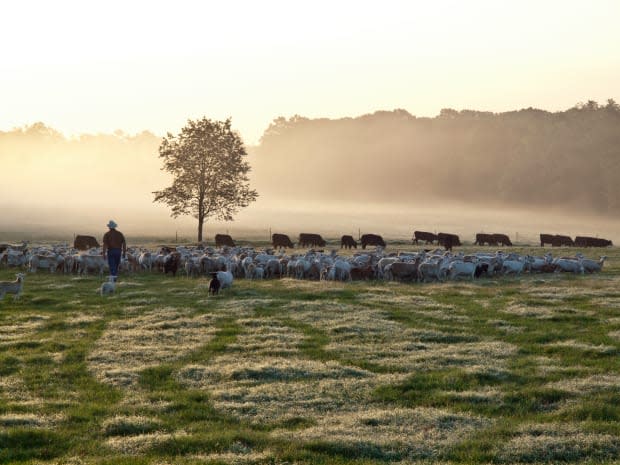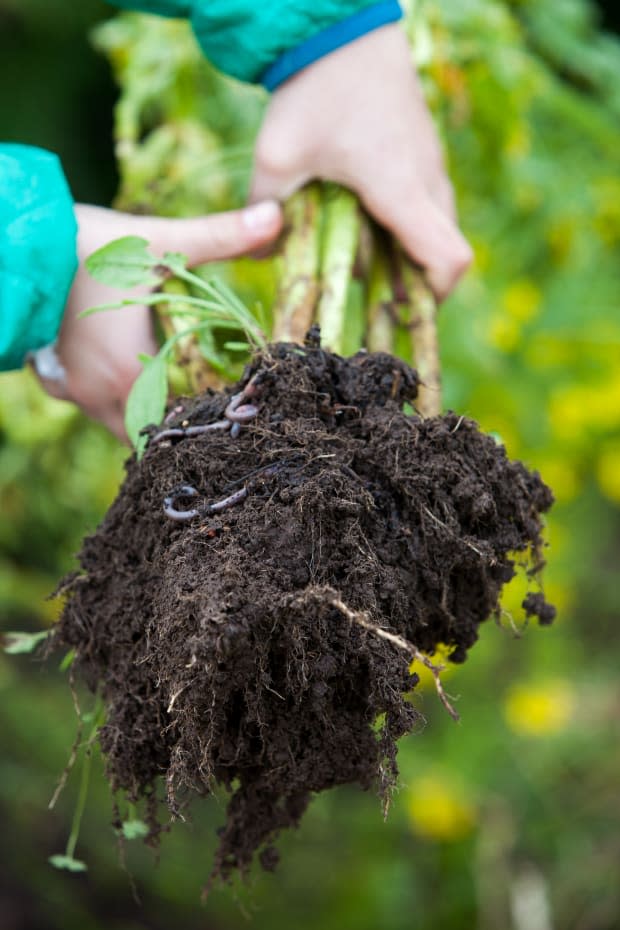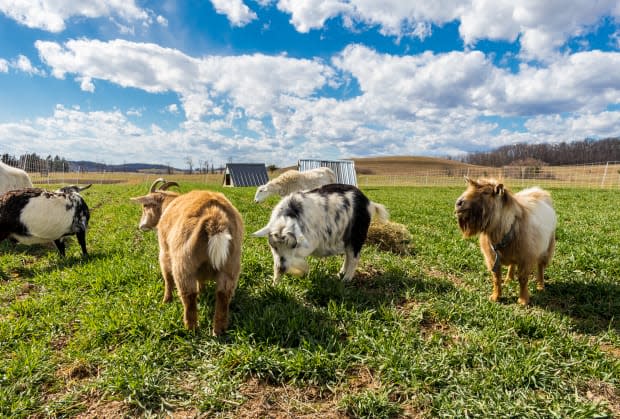The Next Wave of Sustainable Fashion Is All About Regenerative Farming
What you need to know about the sustainability buzzword that's going to be everywhere in a few years.

"I want you to act as you would in a crisis. I want you to act as if our house is on fire. Because it is."
These words from Nobel Prize-nominated teen activist Greta Thunberg helped galvanize 1.4 million people to take to the streets earlier this month to participate in the global school strikes for climate action. And while Thunberg's message about the environment was alarming, the underlying assumption was that there's real hope for addressing climate change.
When human beings have made such a mess of the planet, where does that hope arise from? For many experts, a groundbreaking way of thinking about agriculture — regenerative farming — offers one of the most concrete reasons for optimism.
"Agriculture really represents the best chance that we have of mitigating and ending the climate crisis," said Patagonia CEO Rose Marcario at the National Retail Federation in January. "The science is saying that if we converted all industrialized agriculture to regenerative, organic practices, we could sequester all the world's carbon."
The promise that regenerative farming practices could literally reverse climate change is staggering, but there's data to back it — and pioneering companies like Patagonia, Kering and Prana are investing in it as a result. In fact, they're so convinced of its potential for world-changing impact that it's not hard to imagine regenerative farming becoming as buzzy in the future as the circular economy is now.
"This is something that could create and will create the future of sustainability," claims Prana's Sustainability Director Rachel Lincoln in a phone interview.
So what exactly is regenerative agriculture, and how is it going to deliver on the massive claims being made about it? Here, we break down everything you need to know.
What is regenerative farming?
While much conversation about the environment hinges on the idea of sustainability — that is, maintaining the planet's current state and taking care not to degrade it — regenerative agriculture assumes that some things have already been so damaged that they need to be built back up before we can get by with merely sustaining them.
Regenerative agriculture applies that idea specifically to soil health. According to nonprofit Regeneration International, the term refers to "farming and grazing practices that... reverse climate change by rebuilding soil organic matter and restoring degraded soil biodiversity."
The average person may think of soil as belonging in the same category as something non-living like a rock, but truly healthy soil is teeming with living microorganisms like fungi, bacteria and protozoa. Elizabeth Whitlow, executive director of the Regenerative Organic Alliance, compares these to probiotics in the human gut. Just as we need good bacteria to keep our digestive system running smoothly, the soil needs a community of microorganisms to help it grow healthy plants, sequester carbon and absorb water properly. While some kinds of farming destroy these microscopic life forms, regenerative farming helps build them back into the ecosystem.
Vice President of Social and Environmental Responsibility at Patagonia Cara Chacon thinks of regenerative agriculture as essentially starting with the foundation laid by organic farming and taking it to the next level. Ideally, she says in a phone interview, it should represent the "holy grail of agricultural responsibility," encompassing best practices for farming that benefit soil, the plants and animals being farmed, the people doing the farming and those using the farmer's end products.

How is it practiced?
The practices involved in regenerative agriculture can be wide-ranging and partly depend on the kind of farm in question. According to Whitlow, they might include using compost rather than synthetic fertilizer, planting windbreaks (rows of trees at the edge of a field that shelter it from wind, preventing soil erosion), avoiding synthetic pesticides, rotating crops (growing different kinds of crops on the same plot in different seasons to optimize nutrients in the soil), intercropping (growing two or more crops in the same space at the same time, like planting food crops between rows of cotton) and employing a no-till or low-till approach (planting seeds without digging up the ground).
These practices have a range of benefits, from slowing soil erosion to making plants more resilient to pests to making food crops more nutrient-dense. According to Kering's Sustainability Programs Director Géraldine Vallejo, they also result in higher-quality fibers and leathers, which is a clear boon for luxury producers. Besides sequestering carbon, regeneratively-farmed land can help combat other side effects of climate change, like flooding, by making land more able to absorb water.
"There are areas where you can see a regenerative farm right alongside a conventional farm and the conventional farm has streams of muddy water coming off of it, and the regenerative farm is just absorbing it like a giant sponge," explains Whitlow on the phone. "It's said that it can absorb eight times more water."
Who's already doing it?
Regenerative farming has seen its most significant traction in the natural food space, but fashion brands are making serious inroads, too. In December, Kering announced a partnership with the Savory Institute, an NGO dedicated to the support of holistic land management and regenerative practices. The goal of the partnership is to help identify and develop a network of farms that Kering can use to source leather and fibers like cashmere, wool and cotton.
"Two thirds of environmental impact takes place at the very beginning of the supply chain at the raw material level," explains Vallejo on the phone. "We knew that if we wanted to be efficient in reducing our environmental impact, we had to act on that."
Savory's global reach and scientific approach to data collection made it an appealing partner for Kering, which is looking to slash its environmental impact 40 percent by 2025 and needs concrete ways to monitor its progress.
Patagonia and Prana are two other labels that have skin in the regenerative farming game. Both are allies of the Regenerative Organic Alliance, the organization headed by Whitlow that is trying to create a Regenerative Organic Certification as a standard for what regenerative farming actually means (similar to the way that the USDA Organic certification regulates what can legally be described as "organic farming"). Patagonia's Rose Marcario is also on ROA's board, and her brand is currently working on two pilot projects in India to convert existing organic cotton farms into fully regenerative ones.

What are the challenges?
Although regenerative farming holds incredible promise for addressing environmental problems, obstacles remain. Achieving regenerative certification, once the certification is finalized, will present an additional cost for farmers, which may be prohibitive. And since it's a multi-year process to convert a farm fully, it can be hard for farmers to invest if they don't have a brand promising to pay a premium from the outset. Although Whitlow dreams of a fund that could subsidize the cost of certification ("all the great farmers have to pay to prove how great they are!" she laments), no such fund currently exists.
The potential co-opting and greenwashing of the term "regenerative agriculture" also represents a threat. The Regenerative Organic Certification was essentially conceived of to combat this outcome. Players like Dr. Bronner's, Patagonia and Prana saw the growing buzz around regenerative farming and wanted to make sure it was a well-defined term so that no one could claim to be "regenerative" based on the fact that they were a low-till operation that also happens to use a ton of toxic herbicides, for example.
At the moment, the regenerative farming movement is new enough that its results — i.e. clothing derived from regeneratively farmed fibers — won't be widely accessible to fashion customers for awhile. (Patagonia, for example, hopes to be able to incorporate regenerative cotton from its pilot farms into product lines in two to six seasons.)
But with the incredible environment-saving potential of regenerative farming, conscious brands and consumers can hardly afford to overlook it.
"We don't want to close our eyes and say, 'we're a fashion group, we're not linked with agriculture,'" says Kering's Vallejo. "We think it's our responsibility to encourage the best practices of today."
